 |
RET 2001 Travel Log
What our teachers did on their summer vacation
|
 |
The teachers arrive at the U.C. Santa Cruz campus and descend en masse on the unsuspecting Santa Cruz Institute for Particle Physics (SCIPP). |
 |
Our team sets to work, hatching plans, bringing their knowledge of cosmology up to date, and designing small weather-balloon-borne experiments to be launched in Texas... |
 |
...and updating the hardware for SCIPP's Tesla Coil Outreach Demo... |
|
...which they present to a group of high school students visiting for the Johns Hopkins CAA Summer Science Program. |
 |
They attend the GLAST Collaboration Meeting held at Stanford University. The small working groups that they attend are especially enlightening:
Stuart Briber & Paul Graham attended the New Physics Working Group, while Steve Kliewer attended the GRB & Solar Flare Working Group, and James Dann met with GLAST event-display software designers Gloria Spandre and Nick Lumb, who generously helped him master the software they'd designed for the GLAST mission. |
 |
Racing from the meeting to catch a flight for Texas, our valiant crew arrives at the...
National Scientific Balloon Facility: Palestine, TX |
 |
The gondola which will carry the GLAST detector tower aloft. |
 |
"Tiny Tim", the launch vehicle, test mated to the GLAST-BFEM gondola
on the day prior to the launch.
(For a sense of Tiny Tim's scale, note the person in the lower-right-hand corner.) |
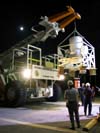 |
The Gondola is loaded at 4am to be transported to the launch pad
for a planned 7 am launch. |
 |
On the launch pad. All dressed up and nowhere to go.
Low level winds (100 ft to 1000 ft) were too strong for a safe launch. Launch was delayed hour by hour as test balloons and a small tethered (1000 ft) balloon were carefully studied and winds predicted. |
 |
Two helium trucks, the launch spool, and the balloon crate are assembled and waiting. The day is getting extremely hot. The surface winds are very still, hot, & humid. The grassy field is alive with grasshoppers and cicada. |
 |
Finally, after about 4 hours of delay, the balloon is hauled out of its crate and strung along the ground. It is 526 ft long and weighs over 4000 lbs. Once this step is done the balloon cannot be reused even if the flight is canceled. |
 |
The top of the balloon is doubled back after wrapping around the launch spool. A disk with remotely controlled valves and pyrotechnic termination devices is installed at its top. This can be used to bring it back down
if all else fails. |
 |
Finally the helium begins to flow. |
 |
Two fill tubes are used to fill only the very topmost part of the balloon. Only about 1/250 of the balloon's available volume is used at ground level. At float altitude, the helium will have expanded 250 times to a volume of 29 million cubic feet. |

Panorama showing the balloon nearly ready for launch.
The full rig streches nearly 1000 ft along the ground.
From left to right: The balloon is about 600ft long, most of it still stretched along the ground. The balloon is attached to a parachute (red and white), followed by a ladder like rig of cables which crosses over the top of Tiny Tim and then finally attaches to the gondola hanging in front.
A high-resolution copy of this panorama can be downloaded here. (2.0 MB). |
 |
Spool Release
The heavy spool that has held the inflated portion of the balloon down, is suddenly released and the balloon majestically rises above Tiny Tim. |
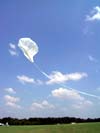 |
The time is 11:50am, nearly 5 hours after planned liftoff. |
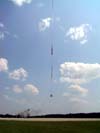 |
Without even needing to maneuver under the balloon, Tiny Tim immediately releases the GLAST-BFEM gondola and the flight is underway. |
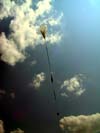 |
Up, Up, and Away
A nearly perfect launch, straight up, the balloon seems to hang above us, slowly dwindling, for over an hour. Even after its westward drift becomes more obvious, it is still clearly visible hours later before finally dwindling to the west and getting lost behind some nearby clouds. |
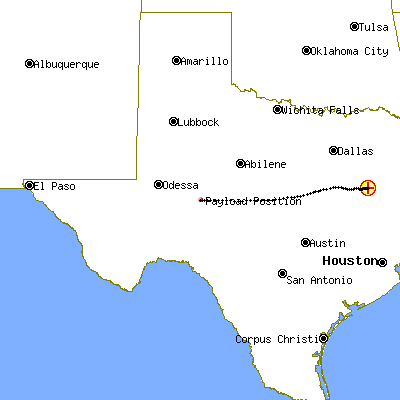
Ground Track for "Thompson Flight 1579" 8/4/01
The balloon ascended smoothly for 2 hr 20 min before floating at a constant 125,000 ft for another 3 hours and drifting at a rate of 80 MPH westward before returning to Earth. |
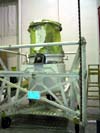 |
Trouble struck after 1 hr 20 min. Apparently a slow leak brought the pressure in the gondola down to that of the near-vacuum outside. The GLAST detector didn't mind -- it's designed to operate in vacuum -- but the onboard hard drives were not. The drives crashed, and from this point on, the mission had to rely on real-time air-to-ground telemetry to record event data.
Fotunately, this real-time telemetry data was more than enough to accomplish
the mission's primary objectives of analyzing
GLAST's response to both cosmic rays and gamma rays.
|
 |
However, the leak was too slow for its quick trip down. As the gondola approached ground level (and the outside pressure approached one atmosphere) it still contained a near-vacuum inside. The pressure containment shell had been designed to withstand the opposite conditions -- high pressure inside, low pressure outside -- and was crushed by this unexpected reversal. Good thing the mission was already over, and the data safely in the hands of researchers on the ground...
This picture shows the instrument tipped on its side and with the top of the containment shell removed. |
 |
After chasing the Balloon across half of Texas in a rented van, Stuart and Joe are onhand to assist in the recovery of the slightly crunched-up payload... |
 |
...despite the very real danger that they might have to wade out into the middle of the parachute, which looks like a hell of a lot of fun. |
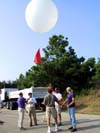 |
Back at the Balloon Facility,
the chase team are running on very little sleep as, with the generous help
from the Goddard crew, they launch the Tethered-Balloon
Experiments they had designed back at SCIPP. |
 |
The Team returns to Santa Cruz
where, thanks to the earlier help of Gloria Spandre and Nick Lumb, they're
among the first in the world to view the Event Data
(both cosmic ray and gamma ray hits) recorded by the GLAST detectors during
their flight. |
 |
UCSC cosmologist Joel Primack is kind enough to give them an impromptu seminar on the big issues of the universe, helping to answer the questions the GLAST activity had raised in their minds... |
 |
...and with that, our Team disperses, to take up their cover identities as mild-mannered physics teachers.
Until RET 2002... |



























